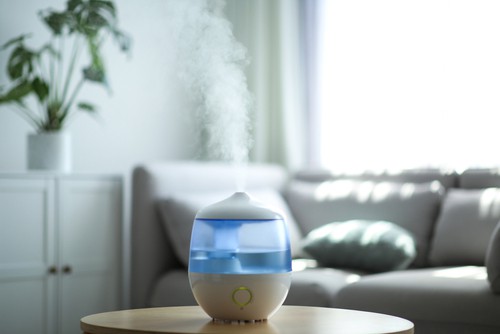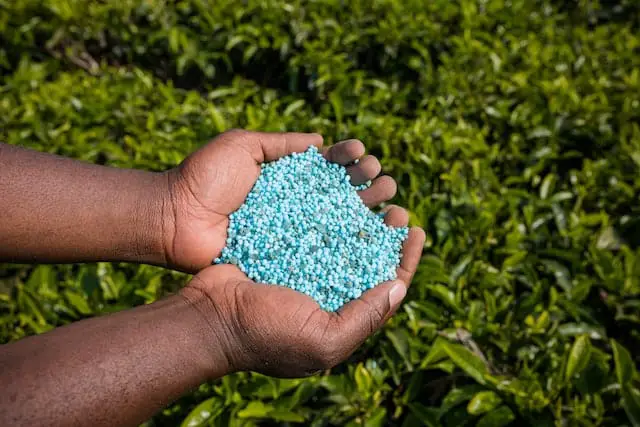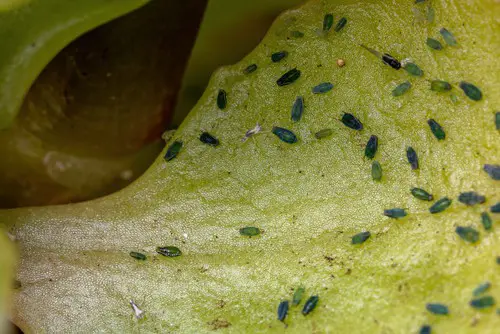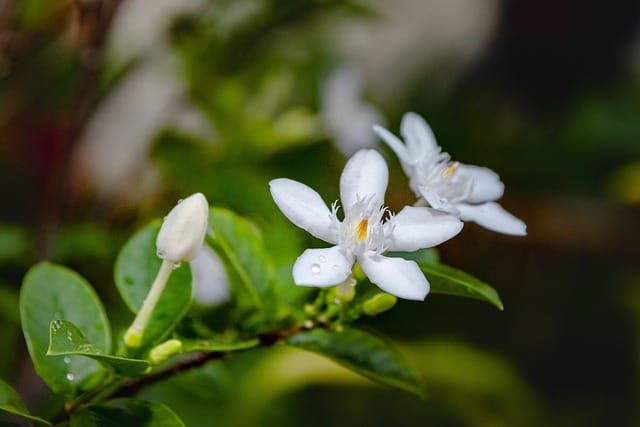Gardenias are prized for their fragrant, creamy-white flowers and glossy, dark green leaves. However, one of the most common problems that gardeners face when growing gardenias is the appearance of black spots on the leaves.
These unsightly spots can be caused by a variety of factors, including fungal diseases, insect infestations, and environmental stressors.
Identifying the cause of black spots on gardenia leaves is crucial to determining an effective treatment plan. In some cases, the spots may be harmless and purely cosmetic, while in others they may indicate a more serious underlying issue.
Treatment options range from simple cultural practices like pruning and watering to more intensive measures like fungicide applications and pest control. With proper care and attention, gardeners can prevent and manage black spots on gardenia leaves, helping their plants thrive and bloom.
Key Takeaways
- Understanding the causes of black spots on gardenia leaves is essential for proper treatment.
- Treatment options range from cultural practices to chemical applications.
- Preventing black spots through proper care and attention is the best strategy for long-term gardenia health.
See these other related posts:
Understanding Gardenia Diseases

Gardenias are known for their fragrant flowers and glossy green leaves, but they are also susceptible to a variety of diseases. Understanding these diseases can help gardeners identify and treat them before they cause serious damage to the plant.
1. Fungal Diseases
Fungal diseases are a common problem for gardenias, and they can cause a range of symptoms, including leaf spots, stem canker, and wilt. Phomopsis gardeniae is a fungal disease that causes stem canker and dieback, while Phytophthora is a soil-borne fungal disease that can cause root rot and wilt.
Powdery mildew is another fungal disease that can affect gardenias, causing a white, powdery coating to form on the leaves.
2. Leaf Spot
Leaf spot is a common symptom of many gardenia diseases, including fungal diseases and bacterial leaf spot. This symptom appears as small black or brown spots on the leaves, which can eventually lead to leaf drop and defoliation.
Gardeners can prevent leaf spot by providing good air circulation and avoiding overhead watering, which can spread the disease.
3. Sooty Mold
Sooty mold is a black, powdery coating that can form on the leaves of gardenias. It is caused by honeydew, a sticky substance produced by insects such as aphids and scale insects. Gardeners can control sooty mold by controlling the insect population with insecticides or by using natural predators such as ladybugs.
4. Erysiphe Polygoni
Erysiphe polygoni is a fungal disease that causes powdery mildew on gardenias. It appears as a white, powdery coating on the leaves, stems, and flowers of the plant. Gardeners can prevent this disease by providing good air circulation and avoiding overhead watering.
Overall, gardenias are susceptible to a range of diseases, including fungal diseases, leaf spot, sooty mold, and powdery mildew. Gardeners can prevent these diseases by providing good air circulation, avoiding overhead watering, and controlling insect populations.
Identifying Black Spots on Gardenia Leaves
Gardenias are a popular shrub that can add a touch of elegance to any garden or landscape. However, black spots on gardenia leaves can be a sign of a problem that needs attention. Identifying the cause of these spots can help gardeners take the appropriate steps to remedy the situation and keep their gardenias healthy and vibrant.
Symptoms
Black spots on gardenia leaves are a common symptom of several different problems. The spots can appear as small dots or larger patches, and they may be accompanied by other symptoms such as yellowing leaves, leaf drop, and stunted growth.
In some cases, the spots may be raised or sunken, and they may have a distinct border or appear to blend into the surrounding tissue.
Causes

Black spots on gardenia leaves can be caused by a variety of factors, including fungal and bacterial infections, insect infestations, and environmental stress. Some of the most common causes of black spots on gardenia leaves include:
- Fungal Infections: Fungal infections such as sooty mold, powdery mildew, and black spot can all cause black spots to appear on gardenia leaves. These infections are often accompanied by other symptoms such as leaf yellowing and drop.
- Bacterial Infections: Bacterial infections such as bacterial leaf spot and canker can also cause black spots to appear on gardenia leaves. These infections may be more severe than fungal infections and can cause significant damage to the plant.
- Insect Infestations: Insect infestations such as scale and mealybugs can cause black spots to appear on gardenia leaves. These insects feed on the sap of the plant, which can lead to leaf yellowing and drop as well as the appearance of black spots.
- Environmental Stress: Environmental stressors such as drought, excessive heat, and cold temperatures can all cause black spots to appear on gardenia leaves. These stressors can weaken the plant and make it more susceptible to infections and other problems.
Spotting Infected Leaves
To identify infected leaves, gardeners should look for black spots on the leaves, which can be accompanied by other symptoms such as yellowing, wilting, and leaf drop. Gardeners should also inspect the undersides of the leaves, where insects and fungal spores may be present.
If gardeners suspect that their gardenias are infected, they should take steps to remedy the problem as soon as possible. This may include pruning infected leaves, treating the plant with fungicides or insecticides, and improving growing conditions to reduce stress on the plant.
Black Spots on Gardenia Leaves – 3 Common Problems
Gardenias are popular ornamental plants known for their fragrant white flowers and glossy, dark green leaves. However, gardeners often encounter black spots on gardenia leaves, which can be an indication of various underlying problems. In this section, we will discuss the main causes of black spots on gardenia leaves.
1. Fungal Infections
Fungal infections are one of the most common causes of black spots on gardenia leaves. The fungus responsible for this problem is usually a type of sooty mold that grows on the surface of leaves. The mold appears as a black, powdery coating on the leaves, and it is often accompanied by yellowing or browning of the affected leaves.
Fungal spores can spread easily through the air and infect gardenia leaves. High humidity, warm temperatures, and poor air circulation can create ideal conditions for fungal growth. Overwatering and poor drainage can also contribute to fungal infections by creating a moist environment that favors fungal growth.
2. Pest Infestations
Sucking insects, such as aphids, whiteflies, and scales, are another common cause of black spots on gardenia leaves. These insects feed on the sap of gardenia leaves, and as they do so, they secrete a sticky substance known as honeydew. The honeydew can attract fungal spores, which can then grow on the leaves and cause black spots.
Pest infestations can be prevented by regularly inspecting gardenia plants for signs of insect activity. If an infestation is detected, it can be treated with insecticidal soap or other appropriate treatments.
3. Environmental Problems

Environmental problems, such as low humidity, high temperatures, and poor air circulation, can also contribute to the development of black spots on gardenia leaves. Low humidity can cause the leaves to dry out, which can make them more susceptible to fungal infections.
High temperatures can stress the plant, making it more vulnerable to pests and diseases. Poor air circulation can also create a stagnant environment that promotes fungal growth.
To prevent environmental problems, gardenias should be grown in a location with moderate temperatures and good air circulation. Humidity levels can be increased by placing a humidifier near the plant or by misting the leaves with water. Overwatering should be avoided, and gardenias should be grown in well-draining soil with a pH between 5.0 and 6.5.
Treatment Options
Gardenia shrubs are susceptible to black spots on their leaves due to various reasons, including insect infestation, fungal infections, and environmental stress. Treating black spots on gardenia leaves involves a combination of chemical treatments and organic remedies.
Chemical Treatments
Chemical treatments involve the use of fungicides, myclobutanil, systemic insecticides, and pesticides. Fungicides are a type of pesticide that specifically targets fungi and can be used to control black spot infections on gardenia leaves. Myclobutanil is a systemic fungicide that can be applied as a spray or drench to control fungal infections.
Systemic insecticides are absorbed by the plant and can control insect infestations that cause black spots on gardenia leaves. Pesticides can also be used to control insect infestations, but they are not recommended for gardenia shrubs due to their sensitivity to chemicals.
Copper-based fungicides are another option for controlling fungal infections on gardenia leaves. These fungicides work by preventing the growth and spread of fungi.
Organic Remedies
Organic remedies for black spots on gardenia leaves include horticultural oil, neem oil, and other organic treatments. Horticultural oil is a type of oil that is applied to the leaves and stems of plants to control insect infestations. Neem oil is an organic oil that is derived from the neem tree and can be used to control fungal infections and insect infestations.
Other organic treatments for black spots on gardenia leaves include pruning infected leaves and branches, improving soil drainage, and providing adequate sunlight and water to the plant. These remedies can help prevent fungal infections and insect infestations from occurring in the first place.
Prevention Strategies

Gardenias are susceptible to various diseases, including leaf spot, which causes black spots on the leaves. However, with proper care and prevention strategies, gardeners can keep their gardenias healthy and beautiful. Here are some prevention strategies to keep your gardenias healthy and prevent black spots on their leaves.
1. Proper Watering
Proper watering is essential to prevent leaf spot in gardenias. Overwatering can lead to waterlogged soil, which can cause root rot and other fungal diseases. On the other hand, underwatering can cause stress to the plant and make it more susceptible to diseases.
To prevent overwatering, gardeners should ensure that the soil is well-drained and not waterlogged. They should also avoid overhead watering, which can spread fungal spores. Instead, they should water at the base of the plant.
2. Optimal Fertilizing
Gardenias require proper nutrients to grow and thrive. Proper fertilizing can prevent nutrient deficiencies and improve the plant’s overall health, making it more resistant to diseases.
Gardeners should fertilize their gardenias with a balanced fertilizer, such as a 10-10-10 or 16-4-8. They should apply the fertilizer in early spring and again in mid-summer. Overfertilizing can lead to nutrient burn and make the plant more susceptible to diseases.
3. Effective Pruning
Pruning is an essential part of gardenia care. It helps to promote healthy growth and prevent diseases such as leaf spot. Gardeners should prune their gardenias in late winter or early spring before new growth begins.
They should remove any dead or diseased branches, as well as any branches that are crossing or rubbing against each other. They should also remove any suckers that are growing from the base of the plant.
4. Mulching
Mulching is an effective way to prevent leaf spot in gardenias. It helps to retain moisture in the soil and prevent fungal spores from splashing onto the leaves. Gardeners should mulch their gardenias with a 2-3 inch layer of organic mulch, such as pine straw or bark.
5. Chelated Iron
Gardenias require iron to grow and thrive. Iron deficiency can cause yellowing of the leaves and make the plant more susceptible to diseases such as leaf spot. Gardeners can prevent iron deficiency by applying chelated iron to the soil.
Chelated iron is a form of iron that is easily absorbed by the plant. Gardeners should apply chelated iron to the soil in early spring and again in mid-summer. They should follow the manufacturer’s instructions for application rates.
Dealing with Pests

Identifying Pests
Gardenias are susceptible to several pests that can cause black spots on their leaves. These pests include sucking insects such as aphids, scales, and whiteflies. These insects feed on the sap of the plant and excrete a sticky substance called honeydew. This honeydew can attract mold, which can cause black spots on the leaves.
Identifying the specific pest causing the black spots is crucial for effective pest control. Mealybugs are the most common gardenia leaf pests, and they are usually found in masses along the leaves of the gardenia. They are white and tend to hide along protected areas of the plant.
Eradicating Pests
Controlling the insects that produce honeydew is essential to get rid of black spots on gardenia leaves. Insecticides like neem oil are effective against mealybugs and other pests. Horticultural oil is also useful for controlling insect populations.
For whiteflies, insecticidal soap or horticultural oil sprays are effective, but the plant must be sprayed thoroughly so that the soap or oil contacts the insects on the underside of leaves. Foliar injury from soaps and oils may occur on plants under drought stress.
If using insecticides, it is important to follow the instructions on the label carefully. Overuse of insecticides can lead to resistance among pests, making it harder to control them in the future.
Regularly inspecting gardenias for pests and promptly addressing any infestations can help prevent black spots on the leaves. Removing any heavily infested leaves or branches can also help control the pest population.
Specifics for Potted Gardenias
Potted gardenias (Gardenia jasminoides) are a popular choice for indoor and outdoor gardening enthusiasts. However, they are susceptible to black spots on their leaves, which can be caused by several factors.
One common reason for black spots on potted gardenia leaves is bud drop, which is a natural process that occurs when the plant is dormant or stressed. When gardenias are stressed due to improper growing conditions, they may drop their buds, which can lead to black spots on the remaining leaves.
Overwatering is another common cause of black spots on potted gardenias. Gardenias prefer well-drained soil, and overwatering can lead to root rot, which can cause black spots on the leaves. It is important to water gardenias only when the soil is dry to the touch, and to ensure that the pot has proper drainage.
Phytophthora root rot is a fungal disease that can also cause black spots on potted gardenia leaves. This disease is caused by overwatering and poor soil drainage. To prevent this disease, it is important to use well-draining soil and to avoid overwatering.
Iron chlorosis is another potential cause of black spots on potted gardenia leaves. This condition occurs when gardenias are not receiving enough iron, which can cause the leaves to turn yellow and develop black spots. To prevent iron chlorosis, it is important to fertilize gardenias with a fertilizer that is high in iron.
In general, growing potted gardenias requires proper care and attention to prevent black spots on the leaves. It is important to provide the plant with well-draining soil, to water it properly, and to fertilize it regularly. By following these simple guidelines, gardeners can enjoy healthy, beautiful potted gardenias without the worry of black spots on the leaves.
Additional Information on Gardenias

Gardenias are evergreen shrubs that are known for their beautiful white blooms and pleasing scent. They are popular in landscaping and are often used to add structure and interest to gardens. However, gardenias are susceptible to a variety of problems, including black spots on their leaves.
One common problem that affects gardenias is the presence of galls. These are abnormal growths that form on the leaves, stems, or roots of the plant. They are caused by insects or fungi and can be unsightly, but they generally do not cause serious harm to the plant.
Environmental problems can also affect gardenias. For example, they may suffer from drought stress or damage from extreme temperatures. It is important to provide gardenias with the proper care and maintenance to help them thrive. This may include regular watering, fertilization, and pruning.
Gardenias are closely related to other plants, such as camellia and holly. They have similar care requirements and may be affected by many of the same problems. For example, all three plants may suffer from leaf spot diseases, which can cause black spots on the leaves.
Frequently Asked Questions
How to remove sooty mold from gardenia leaves?
Sooty mold is a fungus that grows on the honeydew excreted by insects such as scale and aphids. To remove sooty mold from gardenia leaves, one must first get rid of the insects.
Horticultural oil can be used to spray the gardenias, making sure to wet both the tops and undersides of the leaves, as well as the stems. The mold will go away once the insects are eliminated. It may be necessary to spray more than once.
What causes black edges on gardenia leaves?
Black edges on gardenia leaves can be caused by a variety of factors, including overwatering, underwatering, pests, or disease. One common cause is a fungal disease called leaf spot, which can be treated with a fungicide. It is important to remove any affected leaves to prevent the spread of the disease.
What is the reason for gardenia buds turning black?
Gardenia buds turning black can be a sign of a fungal disease called bud rot. This disease can be caused by overwatering, poor drainage, or high humidity.
To prevent bud rot, it is important to ensure that the soil is well-draining and not watered excessively. Infected buds should be removed and destroyed to prevent the spread of the disease.
How to treat gardenia fungus?
Gardenia fungus can be treated with a fungicide. It is important to remove any affected leaves or flowers to prevent the spread of the disease. To prevent fungal diseases, it is important to ensure that the gardenia plant is not overwatered and has good air circulation.
How to prevent black spots on gardenia leaves?
Black spots on gardenia leaves can be prevented by ensuring that the plant is not overwatered, has good air circulation, and is not planted in a location with too much shade.
It is also important to remove any affected leaves to prevent the spread of disease. Regularly inspecting the plant for pests and using horticultural oil to eliminate them can also prevent the growth of sooty mold.
What are the signs of an overwatered gardenia plant?
Signs of an overwatered gardenia plant include yellowing leaves, wilting, and root rot. It is important to ensure that the soil is well-draining and not watered excessively. Gardenias prefer moist, but not waterlogged, soil.

Hey, I’m Lisa and I’ve been an avid gardener for over 30 years. I love writing, talking and living in the garden! Feel free to connect with me on my socials below

